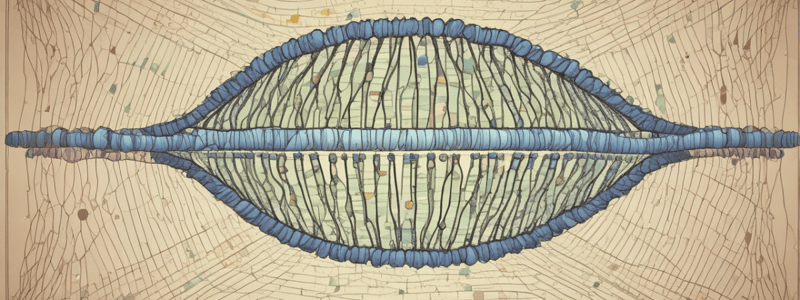Podcast
Questions and Answers
What is the role of oncogenes in cancer development?
What is the role of oncogenes in cancer development?
- Inhibit cell division
- Repair DNA damage
- Remove mutated genes
- Accelerate cell division (correct)
Which genes are primarily responsible for DNA damage repair associated with hereditary breast and ovarian cancer?
Which genes are primarily responsible for DNA damage repair associated with hereditary breast and ovarian cancer?
- BRCA1 and BRCA2 (correct)
- TP53 and MMR genes
- KRAS and BRAF
- APC and RET
Which cancer syndromes are known for high penetrance susceptibility?
Which cancer syndromes are known for high penetrance susceptibility?
- Colon cancer and p16 syndrome
- Familial paraganglioma and melanoma
- Cowden syndrome and Li-Fraumeni syndrome (correct)
- BRCA1 and MMR genes
Which of the following is an inherited cancer susceptibility feature?
Which of the following is an inherited cancer susceptibility feature?
What type of repair mechanism is implicated in Lynch syndrome?
What type of repair mechanism is implicated in Lynch syndrome?
Which cancer has the highest proportion associated with hereditary factors according to the provided data?
Which cancer has the highest proportion associated with hereditary factors according to the provided data?
Which of the following mutations is primarily associated with familial adenomatous polyposis (FAP)?
Which of the following mutations is primarily associated with familial adenomatous polyposis (FAP)?
What mechanism of DNA repair is referred to as 'nucleotide excision repair'?
What mechanism of DNA repair is referred to as 'nucleotide excision repair'?
What is the estimated typical difference between two individuals’ genomes?
What is the estimated typical difference between two individuals’ genomes?
Which of the following statements about somatic mutations is accurate?
Which of the following statements about somatic mutations is accurate?
What does Knudson’s two-hit hypothesis suggest about cancer development?
What does Knudson’s two-hit hypothesis suggest about cancer development?
Which of the following is a characteristic of tumor suppressor genes?
Which of the following is a characteristic of tumor suppressor genes?
Which of the following factors does NOT contribute to cancer risk?
Which of the following factors does NOT contribute to cancer risk?
What role does DNA Mis-Match Repair (MMR) play in genomic integrity?
What role does DNA Mis-Match Repair (MMR) play in genomic integrity?
Which statement is true regarding next generation sequencing (NGS)?
Which statement is true regarding next generation sequencing (NGS)?
What is a potential consequence of damaging DNA that controls cell growth?
What is a potential consequence of damaging DNA that controls cell growth?
Which of the following best describes the majority of cancers?
Which of the following best describes the majority of cancers?
What is the role of targeted therapies like Bevacizumab?
What is the role of targeted therapies like Bevacizumab?
Flashcards are hidden until you start studying
Study Notes
Genetic Variation
- Human genome comprises approximately 3 billion base pairs coding for around 20,000 genes.
- Typical genomic difference between individuals is estimated at 20 million base pairs.
- Genetic variants are essential for individuality (polymorphisms) and contribute to evolutionary processes.
- Pathogenic variants are a significant factor in disease development.
Genome Examination Advancements
- Dramatic improvements in sequencing technology have made genome examination more accessible and affordable.
- Next generation sequencing (NGS) has transformed cancer research and diagnostics.
- The 100,000 Genomes Project has normalized whole genome sequencing in the NHS.
DNA Replication
- Human DNA can replicate at about 1,000 nucleotides per second, with processes taking only a few hours per cell division.
- Error rates during replication are extremely low: 1 per 100,000 base pairs, improved to 1 per 10 million by proofreading, and further to ~10 errors per cell division through mismatch repair (MMR).
Content of the Human Genome
- Genes make up 1.5% of the genome, while 40% includes related sequences like introns and regulatory regions.
- Repetitive DNA constitutes 45% of the genome, including interspersed repeats and telomeres.
Somatic Mutations
- Somatic mutations can lead to cell death, but most often impact non-coding or inactive DNA, causing limited consequences.
- Mutations affecting genes that regulate cell growth can have significant implications.
- Inactive tumor suppressor genes and active oncogenes can enhance cell division, leading to cancer.
Cancer Mechanisms
- Cancer arises from the accumulation of mutations that disrupt the regulation of the cell cycle.
- Tumors originate as clonal expansions of genetically abnormal cells.
- Intrinsic cellular mechanisms typically ensure genomic integrity, which can fail, leading to cancer.
Cancer Risk Factors
- Major factors influencing cancer risk include age, environmental factors (e.g., smoking, diet), obesity, exercise, and infections (e.g., HPV).
- Genetic predisposition and family history also play critical roles.
Targeted Therapies
- Bevacizumab is used for glioblastoma by binding to VEGF to reduce blood vessel formation.
- Imatinib is used in chronic myeloid leukemia (CML) to block tyrosine kinase activity.
Genes Associated with Cancer
- Tumor suppressor genes, like APC, are crucial for regulating cell growth; their loss can lead to sporadic cancers.
- Oncogenes, such as KRAS and BRAF, facilitate rapid cell division when mutated.
- DNA repair genes like BRCA1 and BRCA2 are vital for maintaining genomic integrity.
DNA Repair Mechanisms
- Mismatch repair deficiencies lead to Lynch syndrome, increasing colorectal, ovarian, and endometrial cancer risks.
- BRCA genes are involved in double-strand DNA break repair.
Inherited Cancer Features
- Early onset of cancer, multiple primary cancers, and familial patterns may indicate inherited susceptibility.
High Penetrance Cancer Syndromes
- Examples include BRCA1/BRCA2, Lynch syndrome, Li-Fraumeni syndrome, and hereditary leiomyomatosis.
Hereditary Cancer Syndromes and Proportions
- Breast and ovarian cancers often linked to BRCA1/2, with 5-20% hereditary contribution.
- Retinoblastoma shows a 40% hereditary correlation with mutations in the RB1 gene.
Ovarian and Breast Cancer Specifics
- 15-20% of epithelial ovarian cancers are due to germline BRCA1/2 mutations.
- Triple-negative breast cancer (TNBC) diagnosis occurs in 10-15% of cases, with varying hereditary implications.
Studying That Suits You
Use AI to generate personalized quizzes and flashcards to suit your learning preferences.




